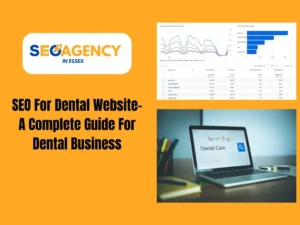Having an online presence is crucial for veterinary practices, 80% of pet owners now search online for veterinary services. The stats are clear—sites on page one of Google get around 71% of the clicks. If your website isn’t there, you’re missing out on new clients every day.
This ultimate guide to SEO for vets websites will help you increase your online visibility, attract more pet owners and grow your practice.
By implementing SEO strategies you can connect with local pet owners, make your practice their first choice and ultimately get more pets the care they need.
Whether you’re starting from scratch or refining your SEO, these tips will get your veterinary website on the road to success.
Let’s get started and make your practice the go to practice for pet owners in your area!
What is Veterinary SEO?
Veterinary SEO is the process of optimising a veterinary website to increase its visibility and ranking in search engine results pages (SERPs) for keywords related to veterinary services.
It’s understanding how search engines work, what pet owners are searching for and the keywords they use to find veterinary care.
The main goal of veterinary SEO is to drive more qualified traffic to the website, attract new leads and ultimately grow the practice.
By optimising content, targeting relevant keywords and technical SEO veterinary SEO helps practices reach more pet owners looking for veterinary services.
Who is Your Target Audience

To attract and engage new clients you need to understand your target audience—pet owners, animal lovers and potential clients in your area. Here’s how to create a tailored approach that speaks to them:
- Identify Your Audience Segments: Define groups like new pet owners, owners of senior pets or those looking for specialist care. Each segment has different needs that your practice can fill.
- What Do They Need and Worry About: What do your audience value most—routine check ups, emergency care or specific treatments. Knowing this lets you target content that matters to them.
- Build Detailed Buyer Personas: Create personas that represent your audience’s behaviour, goals and challenges. For example a new pet owner may be looking for vaccination information, a senior pet owner may be looking for age related care.
- Match Content to Search Behaviour: Research what pet owners search for online. By matching your content to these search patterns you’ll be more likely to appear in front of those looking for veterinary services.
Knowing your audience well will help you build trust, create relevant content and be the go to practice for pet owners in your area.
Keyword Research and Planning

To boost your veterinary website’s visibility, keyword research is essential. Identifying relevant and high-traffic keywords helps you reach pet owners actively searching for veterinary services. Here’s how to get started:
- Identify Relevant Keywords: Research keywords related to veterinary services that potential clients commonly search for, such as “emergency vet near me,” “pet vaccinations,” or “cat dental care.”
- Use Keyword Research Tools: Utilise tools like Google Keyword Planner, Ahrefs, or SEMrush to find high-traffic keywords. These tools provide insights on search volume, competition, and related phrases to expand your keyword list.
- Plan Content Around Target Keywords: Structure your SEO strategy and content creation around your chosen keywords. For example, create blog posts or service pages targeting specific searches like “puppy vaccinations in [City]” or “24-hour vet services.”
A strong keyword plan ensures your content aligns with what local pet owners are searching for, helping your practice appear in more search results and attract new clients.
Optimising Your Veterinary Website For SEO
To attract more visitors and improve search engine rankings, it’s essential to optimise your veterinary website’s structure, design, and content for both users and search engines.
A well-optimised site ensures a better user experience and boosts your visibility in search results. Here’s how to make your website work harder for your practice:
- On-Page Optimisation: Ensure each page on your website is optimised with relevant keywords, clear titles, and informative meta descriptions. Use target keywords naturally within the content to help search engines understand the page’s focus and improve its ranking potential.
- Optimise for Mobile: With many pet owners searching on mobile devices, your website must be fully mobile-responsive. A mobile-friendly design adapts to various screen sizes, providing an excellent user experience on smartphones and tablets, which is also a crucial ranking factor for Google.
- Improve Site Speed: A fast-loading website keeps visitors engaged and reduces bounce rates. Use tools like Google PageSpeed Insights to check loading times and implement improvements, such as compressing images, enabling browser caching, and minimising code where possible.
- Secure with HTTPS: Protect your website and users’ data by using HTTPS, which requires an SSL certificate. Google favours secure sites, and HTTPS helps build trust with visitors, especially when they’re filling out contact forms or booking appointments.
- Use Header Tags and Structured Content: Organise your content with clear headers (H1, H2, H3) to improve readability and structure. Header tags make it easier for search engines to understand your content hierarchy and enhance user navigation.
- Image Optimisation: Use high-quality images of your practice, staff, and services to make your site visually appealing. Compress images to improve load speed, and add descriptive alt text to each image, helping search engines understand the content and improving accessibility.
By optimising your veterinary website, you create a positive user experience, improve search engine rankings, and increase your chances of attracting more local pet owners to your practice.
Local SEO for Veterinarians’ Website

Local SEO is essential for veterinary practices, helping you connect with pet owners in your area and boosting your visibility in local searches. Here’s how to optimise your practice for local search results in the UK:
- Claim and Optimise Your Google Business Profile (GBP): Claiming your Google Business Profile is a crucial step in local SEO. Optimise it by providing accurate and up-to-date information, including your practice’s name, address, phone number, website, hours, and services. Add high-quality photos of your practice, staff, and facilities to make your profile more engaging and build trust with potential clients.
- Use Location-Specific Keywords: Include location-specific keywords in your content, meta descriptions, and headings. Phrases like “veterinary clinic in [City]” or “pet vaccinations in [Region]” help your website appear in local search results, making it easier for nearby pet owners to find you.
- Build Local Citations and High-Quality Links: Ensure consistent citations (mentions of your business name, address, and phone number) across local directories such as Yell, Thomson Local, and vet-specific directories. Additionally, building backlinks from local websites, such as community blogs or partnerships with animal shelters, can further boost your authority in local search results.
By focusing on local SEO, your practice will be more visible to pet owners searching for veterinary services nearby, helping you attract more clients and strengthen your reputation within the community.
Technical SEO for Veterinary Websites

Technical SEO ensures that your veterinary website is easy for search engines to crawl, index, and display in search results. Improving technical SEO also enhances user experience, which is vital for keeping visitors on your site. Here are essential technical SEO practices for veterinary websites:
- Ensure Fast Loading Speed: A fast website is crucial for both user experience and search rankings. Use tools like Google PageSpeed Insights to identify speed issues. Compress images, enable browser caching, and minimise code to reduce load times. Speedier sites rank better and keep visitors engaged.
- Mobile-Friendliness: With a growing number of users searching for veterinary services on mobile devices, your site needs to be fully mobile-responsive. Implement a responsive design that adapts to different screen sizes, providing a seamless experience for smartphone and tablet users.
- Secure Your Website with HTTPS: Security is essential, especially when collecting client information through online forms. Use a trusted SSL certificate to enable HTTPS, which encrypts data and reassures both users and search engines that your site is safe. Google favours HTTPS sites, making it an important ranking factor.
- Optimise URL Structure: Ensure URLs are short, descriptive, and easy to read. Include keywords relevant to the page content, such as “/pet-care-services” or “/contact-vet-in-[City].” Clean URLs help search engines understand page topics and improve user navigation.
- Create and Submit an XML Sitemap: An XML sitemap lists all pages on your site, helping search engines crawl and index your content more effectively. Use tools like Google Search Console to submit your sitemap and monitor indexing status.
- Implement Schema Markup: Schema markup, or structured data, provides additional information to search engines about your site’s content. For veterinary websites, consider adding schema for services, reviews, and locations. This can help your site appear in rich results, like local listings or review snippets, increasing visibility.
- Fix Broken Links and Errors: Regularly check for broken links, 404 errors, and other issues that can harm user experience and SEO. Tools like Ahrefs or Screaming Frog can help identify and fix broken links to keep your site running smoothly.
By focusing on these technical SEO elements, you’ll make your veterinary website more accessible to both users and search engines, improving search rankings, user experience, and engagement.
Building Authority and Links for Veterinary Websites
Building authority through high-quality backlinks is a powerful SEO strategy that can boost your veterinary website’s search rankings and credibility. Here’s how to establish your practice as a trusted source online:
- Acquire High-Quality Backlinks: Focus on earning links from reputable sources related to pet care, veterinary services, and animal health. Websites such as pet blogs, animal welfare organisations, industry directories, and local business directories are excellent sources. Quality backlinks from trusted sites signal to search engines that your website is credible and valuable.
- Leverage Guest Blogging and Outreach: Reach out to pet-related blogs, veterinary journals, and local community sites to contribute guest articles. In exchange, you can often include a link back to your website, helping you reach a wider audience and drive relevant traffic.
- Content Marketing for Link Building: Create valuable content like guides, infographics, or pet care tips that others in the industry may want to link to. By offering informative and shareable resources, you increase the chances of other websites naturally linking back to your content.
- Monitor and Strengthen Trust Signals: Use tools like Ahrefs or Moz to monitor your website’s authority and backlink profile. Regularly check for broken or low-quality links that could harm your site’s credibility. Continuously improving trust signals like HTTPS security, local business listings, and positive reviews also supports your overall SEO authority.
Building high-quality links and authority over time will improve your veterinary website’s ranking potential, helping your practice attract more local pet owners and stand out as a trusted source in the industry.
Common SEO Mistakes to Avoid for Veterinary Websites

Avoiding common SEO mistakes is crucial for improving your veterinary website’s performance and ensuring long-term success. Here are some pitfalls to watch out for:
- Keyword Stuffing and Duplicate Content: Avoid overusing keywords unnaturally in your content, as this can lead to penalties from search engines. Additionally, duplicate content across pages can confuse search engines and hurt rankings. Focus on creating unique, informative content that provides value to your audience.
- Low-Quality Backlinks: Building links from low-quality or irrelevant sites can harm your website’s credibility. Instead, focus on acquiring high-quality backlinks from reputable sources related to veterinary services and pet care.
- Neglecting Technical SEO: Overlooking technical aspects such as site structure, XML sitemaps, and secure HTTPS can negatively impact search engine visibility. Regularly audit your technical SEO to ensure your website is optimised for both users and search engines.
- Ignoring Mobile-Friendliness and Page Speed: Many pet owners search for services on mobile devices, so a mobile-friendly website is essential. Slow-loading pages can lead to high bounce rates and lower rankings. Use tools like Google PageSpeed Insights to identify and resolve speed issues.
- Failing to Keep Up with SEO Trends: SEO is constantly evolving, and outdated strategies can harm your website’s performance. Stay informed on the latest best practices, algorithm updates, and trends to ensure your SEO remains effective and compliant.
By avoiding these common mistakes, you’ll create a stronger foundation for your SEO strategy, helping your veterinary website achieve better rankings and attract more clients.
Getting Professional SEO Help
To elevate your veterinary practice’s online presence, sometimes expert help is the game-changer you need. Here’s how to make sure you’re choosing the right SEO partner:
- Bring in the Experts for Real Results: Imagine your website ranking at the top of search results, effortlessly bringing in new clients. A professional SEO agency can make this a reality, with proven strategies that save you time and boost your practice’s reach.
- Choose Specialists Who Understand Your Field: Not all SEO is the same. Look for consultants who know the veterinary industry inside out and can create tailored strategies that speak to your specific audience and deliver real impact.
- Ensure Safe, Long-Term Results: Protect your website with experts who use only white-hat, ethical SEO techniques. Shortcuts may seem tempting, but trusted professionals focus on sustainable strategies that keep your site secure and build a strong reputation.
The right SEO partner can transform your practice’s growth, helping you connect with more pet owners and become the go-to vet in your area.
Conclusion
Veterinary SEO is essential for boosting your practice’s online presence and reaching more pet owners.
By identifying your target audience, conducting effective keyword research, and optimising your website, you can improve visibility in search results and attract new clients.
Remember to stay updated on the latest SEO trends and best practices to keep your strategy effective and adaptable.
A well-implemented SEO approach helps ensure long-term growth, making your practice a trusted choice for pet care in your area. Start optimising today and watch your online presence thrive!




